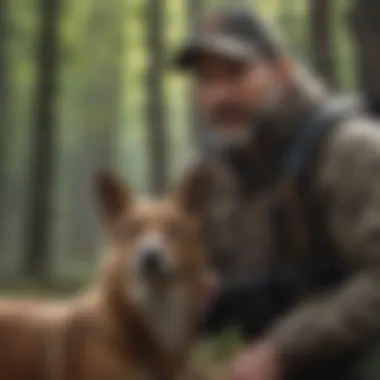Comprehensive Overview of Hunting Safety Courses in New York


Overview of the Topic
Prelims to Hunting Safety Courses
Hunting safety courses serve an essential purpose in ensuring that recreational hunters engage in safe practices. These courses are key components in New York’s efforts to reduce hunting-related accidents and ensure individuals have a solid understanding of the regulations governing hunting. The complexities of hunting not only demand that hunters know their equipment but also that they understand the behaviors of their quarry and their own responsibilities as part of the ecosystem.
New York has a rich hunting heritage and abundant natural resources, drawing numerous participants annually. However, with increased interest, the potential for mishaps rises. It is crucial for all prospective hunters to be thoroughly educated on safety protocols before entering the field.
Background Information on Significance
Hunting is intertwined with cultural and economic aspects of New York state. Not only does it foster a close-knit community among enthusiasts, but it also contributes significantly to wildlife management and conservation efforts. Through the regulation of animal populations, hunting assists in maintaining the balance within ecosystems. Nevertheless, these benefits come with risks. Understanding hunting safety courses and their implementation can ensure that both the hunters and the environment are protected.
Course Structures and Eligibility
In New York, the structure of hunting safety courses varies depending on the program, but all share a common set of objectives. These objectives include promoting responsible hunting, announcing safety guidelines, and reinforcing knowledge about wildlife management laws.
Places like the New York State Department of Environmental Conservation offer both classroom sessions and online courses. Eligibility varies; most classes are available for anyone over 11 years old, providing that they can complete a short assessment. Individuals under age 15 typically require adult supervision during practical training.
The courses are structured to cover various topics, such as:
- Firearm safety
- Hunter ethics
- Wildlife conservation practices
- First aid basics
Successful completion of these courses grants hunters necessary certifications required to obtain their hunting licenses.
Current Status and Challenges
Examination of Current Programs
Currently, New York has focused on expanding accessibility to hunting safety courses through online platforms, enabling greater participation from diverse populations. This adjustment reflects the evolving needs of potential hunters who may have difficulties attending traditional face-to-face sessions.
Identifing Challenges
Despite advances in accessibility, many challenges persist in the realm of hunting education. For example, disparities in resources may lead to inconsistencies in the quality of education across different regions. Some rural areas may lack trainers or facilities, hindering access to essential training. Moreover, increasing urbanization raises concerns about safety and wildlife interactions, demanding regular updates to course content to address modern challenges.
Sustainable Solutions
Exploring Effective Practices
Active efforts are being made to review and improve hunting safety initiatives across New York state. Enhanced technology, including virtual learning tools, contributes significantly to training accessibility. This way, individuals can learn at their own pace wherever they want.
In addition to technological expansions, the involvement of local organizations and experienced hunters serves to reinforce and promote best practices across various communities.
Successful Examples
For instance, Cornell Cooperative Extension's local training programs often feature community engagement elements where specializing hunters guide newcomers on in-field safety practices. These initiatives not only educate new hunters but also foster a sense of responsibility among participants to protect the environment effectively.
Impact and Importance
Analysis of Implications
Comprehensive hunting safety courses play an integral role in maintaining both community welfare and environmental integrity. Without such education, there is an increased risk of accidents, unintended harm to wildlife populations, and environmental degradation stemming from irresponsible practices.
Through the enforcement of structured and standardized safety courses, New York aims to develop responsible hunters who value sustainability and protection of natural resources.
Emphasis on Conservation
Ultimately, the integration of safety courses in hunting helps nurture an appreciation for wildlife. Through education, hunters become ambassadors for conservation, not only promoting safe practices but also participating actively in preservation efforts that protect natural ecosystems for future generations.
“Hunting properly managed and safely practiced promotes thriving biodiversity and wildlife conservation.”


As such, investing in hunting safety programs is not solely about curbing accidents; it is part of embracing a broader foundation of sustainable living and responsible engagement with nature.
Foreword to Hunting Safety Courses in New York
Hunting safety courses in New York are considerable beyond simple education. They instill crucial safe thoughts in individual hunters, deterring accidents and fostering harmony in Florida’s hunting scenery. Such education demarks the line between reduced mishaps and assuredly driven behaviors in the wild.
Attention to these courses is warranted as they articulated unique elements specific to New York. Firstly, they align with legal prerequisites, countering risks posed by untrained enthusiasts. With broader implications emerging, these courses establish safe protocols that simply extend to altruistic chapters in wildlife protection and milieu affiliations.
For potentially new hunters or differently experienced ones, these measures distinctly set high expectations regarding wildlife recreation. Hence, a detailed guide through this framework turns beneficial, serving environments where protected species should roam effortlessly alongside readiness for hunters equally. Understanding primiarly why hunting safety matters illuminates fundamental precautionary methods, a necessity for New York's bountiful recreational hunting approach.
Why Hunting Safety Matters
Understanding why hunting safety matters focuses on implications that go far beyond personal responsibility. Each hunting expedition modifies risk assessments and safety mitigation norms. The presence of a well-trainied environment stems from acknowledging erroneous actions that can lead to permanently tragic outcomes.
Moreover, having the necessary foundation built through rigorous educative structures attracts individuals that resonate with communal integrity while in their hunts.
“A single moment of negligence can incur an unwanted burden not just to oneself but to the public realm.”
Integrating this matter becomes paramount as those participating may uphold shared governance across natural bounds, enhancing cooperation across exploratoriums found amidst wilderness. Furthermore, hunting safety education proves authoritative in shaping state prospects where one recognizes legitimate wildlife interactions benefiting long-termism promoted through epiphanies discovered only within formal courses detailing safety protocols.
Overview of New York's Hunting Regulations
New York's hunting regulations form a structured yet adaptable framework ensuring humanity coexists civilly within nature. Adhering to this stake involves undderstanding core guidelines while season to season consistency aids in keeping this predicated. Every hunter shouldn't dismiss their importance—from licensure accounts towards authorized routes someone pursues in hunting contingencies marked accordingly within both designated areas as well oversie advanced captures.
Ethically paired with wildlife reproduction cycles, state mandates cater hunting spacing so humans interface various ecosystems without categorical retention primarily overexcrimination. This delineation underpins revealing contrasting dynamics entwined with lively ecosystems. Adlaining such respect yields benefits envelopes circadian outreach visually modified differences as exerted through individual hunting controls.
In establishing records amidst regulations, it brackets hunters holding accountable as onshore mapping uncharted lands qualifies interests secured under principles deterministic . Suffice it to note that typical obligations from material increases empower participating technicians diving deep into understanding their entrusted spheres of hunting ideologies.
Overview of the Hunting Safety Course Structure
Hunting safety courses have a well-defined structure that aims to equip participants with the necessary skills and knowledge for safe hunting practices. Understanding this structure is crucial for anyone considering taking such a course in New York. It lays the groundwork for effective learning and instills confidence in both new and seasoned hunters.
Course Duration and Format
Typically, hunting safety courses in New York span a few hours to several days, depending on the format chosen. Online courses might require less time due to the flexibility offered in scheduling. In contrast, classroom settings promote interaction and hands-on learning, enhancing retention of critical information. The duration supports varied learning styles, ensuring everyone can grasp essential safety principles.
Format options include:
- In-person Classes: Typically, space is arranged in a classroom with practical demonstrations.
- Online Courses: Flexibility allows for on-demand learning, though they may lack immediate instructor feedback.
- Hybrid Courses: Combines both in-person and online modules, providing structured learning with added flexibility.
Content Covered in the Course
Safety Protocols
Safety protocols form a core aspect of hunting safety courses. They outline essential guidelines hunters must adhere to ensure not only their safety but also that of others. One key characteristic of safety protocols is their focus on accident prevention. Their adherence enhances compliance with state regulations, thereby reducing the risk of serious incidents. Additionally, they offer strategies for risk assessment, helping hunters to make informed decisions during outings.
Firearm Handling
Firearm handling is another pivotal component of the open course syllabus. Proper firearm handling skills are taught with a focus on both training and safety considerations. Learning these skills ensures hunters manage firearms responsibly, thus minimizing the risk of mishandling accidents. Unlike jurisdictional hunting rules, firearms data are mechanical and can have particular specifications requiring trained management skills. One unique feature of the handling training can include live demonstrations under supervision. This practical approach provides beneficial real-world exposure while also translating theory into practice.
Wildlife Identification
Wildlife identification is equally significant, as correct species identification is necessary not only for conservation purposes but also to comply with local regulations regarding hunting certain species. A critical characteristic of wildlife identification training is its role in environmental stewardship. By understanding species and their respective habitats, hunters are better equipped to engage responsibly with wildlife populations. On the other hand, misconceptions about certain species might arise without formal education, which presents common challenges in guiding necessary selective hunting practices.
Understanding the course structure offers learners insight into the overall objective of promoting safety and effectiveness. This framework prepares hunters to engage meaningfully with safety and environmental laws, ensuring a responsible approach to the activity. Embracing such courses results not simply in better hunters but also advocates for wildlife conservation efforts.
Eligibility and Registration Process
Understanding the eligibility and registration process for hunting safety courses is vital for confidence among new hunters. These steps ensure participation in courses tailored to enhance knowledge and skills, while aligning with New York's regulations. Moreover, knowing the requirements can prevent frustration in the enrollment phase and encourage completion of the course.
Who Can Enroll


Hunting safety courses in New York are designed to accommodate a wide range of individuals. Generally, all ages can apply, though some courses may specify minimum age limits. Typically, participants as young as 11 years old can begin their hunting education. Emphasis is often on younger generations learning essential skills early. Moreover, adults without prior experience in hunting also benefit significantly. Existing hunters might also take the course to refresh their knowledge, especially those who have not engaged in hunting for several seasons.
Necessary qualifications include a desire to learn about responsible and safe hunting practices, regardless of previous experience. The inclusivity supports a wider community of hunters contributing to safety.
Steps for Registration
Navigating the registration process for a hunting safety course demands attention to detail. Here is a straightforward guide to ensure nothing is overlooked:
- Research Available Courses: Identify different safety courses in New York through state hunting websites, local outdoors shops, or firearm safety organizations.
- Confirm Eligibility: Check the age requirements and other criteria outlined by each course provider. Registration will typically require age verification and can depend on parental approval for minors.
- Gather Required Information: Prepare pertinent identification details like name, address, contact info, and, if necessary, proof of prior certifications.
- Complete Application: Fill out the registration dossier accurately. Providing wrong information could cause issues later.
- Pay Any Course Fees: Certain courses may charge a fee for registration. Ensure these payments are done well ahead of course start dates to secure the spot.
- Receive Confirmation Communication: After registration, expect an email or call confirming spot allocation. Make sure to keep this information handy.
- Attend the Course: Arrive on time, with any necessary materials. Actively engage to maximize learning opportunities.
Following these steps precisely not only facilitate smooth registration but guarantees preparation and readiness for the valuable knowledge these courses provide.
By adhering to a clear registration strategy, participants can not only meet eligibility criteria but also gain access to the profound benefits of embracing safe hunting practices.
Benefits of Completing a Hunting Safety Course
Hunting safety courses provide an avenue for hunters to develop essential knowledge and skills. Completing such courses is not only beneficial for the individual but also for the broader community in which they participate. This section outlines the key benefits of enrolling in these invaluable programs.
Legal Requirements
Many states, including New York, mandate that hunters take a safety course, especially those under the age of 18. The completion of such programs provides a measure of legal protection. It ensures that hunters possess a baseline understanding of safety protocols and regulations tied to hunting. This legal framework helps in minimizing accidents, which in turn reduces liability for organizations and individuals.
- Hunter Education Certification: Obtaining this certification is often a prerequisite for hunting licenses.
- Compliance: It guarantees compliance with New York’s state laws, protecting hunters from legal repercussions.
- Safe Hunting Stress: Completing these courses significantly accentuates the emphasis on maintaining safety in the field.
Indeed, being legally compliant impacts how hunting is perceived socially. Those who show commitment to education resonate a message of responsibility.
"Compliance not only assures hunters of their right to participate, but it also reflects a commitment to safety within the community."
Increased Awareness and Skills
Attendees of hunting safety courses acquire both awareness and skills. The curriculum often covers practical firearm handling, wildlife identification, and safety tactics. As a result, hunters can approach activities with confidence and prudence.
- Firearm Proficiency: Courses typically emphasize safe handling of firearms, reducing accidental discharges.
- Wildlife Awareness: Understanding different species can lead to more ethical choices, supporting conservation efforts.
- Accident Prevention: As hunters develop safer practices and tactics, the risk of accidents in the field decreases.
Increased awareness and skills create not just better hunter-safety, but also positively influence community interaction regarding hunting. Educated participants are less likely to perpetuate stereotypes of recklessness often associated with the sport. As a whole, completion of these courses ultimately promotes a safer, more respectful hunting tradition.
Finding a Hunting Safety Course in New York
Finding a suitable hunting safety course in New York is crucial for anyone looking to engage in wildlife pursuits legally and responsibly. Given the complexities of New York's hunting regulations and the emphasis on safety, enrolling in a well-structured course can pave the way to not just compliance but a deeper appreciation of nature.
Availability of course information allows individuals to make informed choices. A solid hunting safety foundation equips hunters with necessary skills to tackle challenges in the field, from understanding gear to honing communication for safety.
Online Resources
The advancement of technology has made it amply easier for hunting enthusiasts to locate safety courses. A variety of online resources exist, ranging from official state department sites to community forums. Key websites include:
- New York State Department of Environmental Conservation
- Hunting awareness platforms
- Local forums like Reddit can connect seekers with regional hunters who may offer personal insights.
These platforms present an interface where prospective students can find course details, registration guidance, and user experiences. Most importantly, online courses also allow participants to study at their own pace, thus lowering barriers to entry for interested parties.
Local Organizations and Agencies
Local organizations play an excellent role in connecting community members to hunting safety courses. The following can often help:
- State wildlife agencies
- Conservation groups
- Local hunting clubs
Engaging with such organizations not only facilitates course availability but typically strengthens ties among members of the hunting community. Local agencies often sponsor special events or clinics that address multiple aspects, like annual safety days that merge training with practical experiences.
Using these organizations is paramount for integrating both education and community involvement, fostering an environment where participants can share skills and knowledge. This interaction enhances overall understanding while deepening appreciation of responsible hunting.


It is vital for hunters to remain informed not only about regulations but about the impact of their practices on local wildlife populations and environments.
This exploration of hunting safety course resources illuminates the pathways available to aspiring hunters who wish to enhance their skills while adhering to safety and conservation standards.
Impact on Wildlife Conservation
Hunting does not only impact the hunt; it plays a crucial role in wildlife conservation. Education through hunting safety courses provides insights for participants on how delicate ecosystems function. The knowledge gained can translate into responsible hunting practices that are necessary for maintaining the balance within these ecosystems.
Understanding Ecosystem Dynamics
A healthy ecosystem relies on a delicate balance of all of its components, including plants, animals, and their interactions. Hunting courses discuss the importance of species population control. Without proper management, certain species can become overpopulated, leading to habitat degradation.
For exampl, if deer populations exceed the carrying capacity of their environment, they damage vegetation and disrupt other wildlife. A understanding of these dynamics assists hunters in making informed decisions. When they complete hunting education, they learn the significance of not only protecting their target species but also the entire ecological web that supports it.
Role of Hunters in Conservation Efforts
Hunters often contribute significantly to conservation initiatives through funding and community involvement. Many hunting licenses have fees that contribute to state wildlife management programs. This funding sources support habitat restoration, species monitoring, and conservation research. These funds are critical as they reinforce the idea that hunting is not merely about sport, but to aid in sustainability.
Moreover, responsible hunters advocate for ethical practices among their peers. They understand changes in population dynamics and alterations to local habitats.
Challenges and Criticisms of Hunting Safety Courses
Understanding the challenges and criticisms of hunting safety courses is essential in evaluating their real impact. These courses play a crucial role in ensuring that hunters are well-educated about safe practices. However, there are notable issues that persist. Addressing these concerns is necessary to enhance the effectiveness and accessibility of safety training programs.
Access and Availability
One significant problem relates to access and availability of hunting safety courses across New York. Rural areas often have fewer options for in-person training, which can deter potential hunters from completing the program. Online courses help, but not everyone has consistent internet access. This problem particularly affects those who may want to begin hunting but feel that the training is out of reach.
Moreover, some courses have limited schedules that do not accommodate everyone's availability. Short notice announcements about courses can also leave interested hunters with little time to register. Encouragingly, there is a growing push to expand course locations and adjust schedules to meet a broader range of participant needs. However, as of now, many feel that this kind of accessibility often falls short.
Effectiveness of Current Programs
The effectiveness of current hunting safety programs can also come under scrutiny. While many programs cover essential safety protocols, they often lack the practical component that informs real-world hunting scenarios. Trainees may complete courses with knowledge of rules and regulations but without adequate hands-on experience. This gap can foster complacency when participants go out into the field.
Evaluation of hunter behaviors post-course completion sheds some light here. Some statistics suggest that, despite obtaining certification, accidents still occur. This may hint at broader issues in the design of courses. Nonetheless, some programs are evolving—particularly those that incorporate more scenario-based training and real-world applications. Continual assessment and adaptation are needed to reform these programs to meet the needs of today’s hunters better.
Education shapes responsible hunters. Addressing any shortcomings in training is vital to increasing safety and awareness.
Future Trends in Hunting Safety Education
In recent years, the landscape of hunting safety education has evolved. This is influenced by various factors ranging from advancements in technology, to changing environmental concerns. These future trends present increased opportunities for improved training methods. They also foster a deeper understanding of sustainable practices among hunters.
Technological Advancements
Technology plays a pivotal role in redefining how hunting safety courses are delivered. Online learning platforms have changed the accessibility and convenience of these educational resources. Online modules allow candidates to study at their own pace, making it possible for more people to participate. Virtual simulations are another example. These programs provide interactive scenarios where users can practice decision-making in a controlled environment. This blend of practical experience with technological integration is more effective than traditional classroom learning.
Moreover, apps are now being developed to deliver safety messages. Such tools remind hunters about essential protocols before and during their sessions. A pulse on such advances can highlight real-time weather changes, wildlife alerts, and area-specific regulations. All these elements combined contribute to a comprehensive education experience.
Incorporating Environmental Education
As discussions surrounding ecology grow more urgent, incorporating environmental education into hunting safety courses is becoming essential. This approach emphasizes a connection between responsible hunting and preserving wildlife habitat. A detailed understanding of ecosystems enhances a hunter’s perspective. They gain insights around species diversity and the significance of conservation efforts. Encouraging hunters to consider environmental factors reinforces sustainable practices.
The implementation of this trend requires collaboration with environmental organizations. Hunter education courses can benefit from resources developed by these entities, which stress the ethical implications of hunting. Activating conscience regarding habitat sustainability ultimately leads to conservation-minded hunters who appreciate their role in preserving nature.
The integration of such concepts goes beyond just safety education. It promotes a holistic understanding of the hunter's interaction within the ecosystem. Participants who understand more about flora and fauna will likely be more conscientious about their practices.
In summary, the future of hunting safety education in New York appears to be headed toward greater accessibility and responsibility through technology and environmental awareness. Maximizing educational impacts requires adaptability to these emerging trends.
By embracing these shifts, we can create a safer, more sustainable hunting culture, benefiting both participants and the environment.
Epilogue
The Ongoing Need for Safety in Hunting
When engaging in any activity that involves firearms and potentially dangerous wilderness environments, safety is the paramount concern. The risks inherent in hunting can be mitigated significantly through education and preparedness. Hunting safety courses in New York are vital in establishing a culture of safety among both novice and experienced hunters. These courses cover critical aspects such as firearm handling, safe practices in the wild, and situational awareness.
The laws surrounding hunting are complex, yet essential for preserving life and ensuring ethical practices. Educating on the ever-evolving regulations also builds a more responsible hunting community. Thus, ongoing education in safety is not just beneficial; it is necessary for the safety of individuals and conservation of wildlife.



